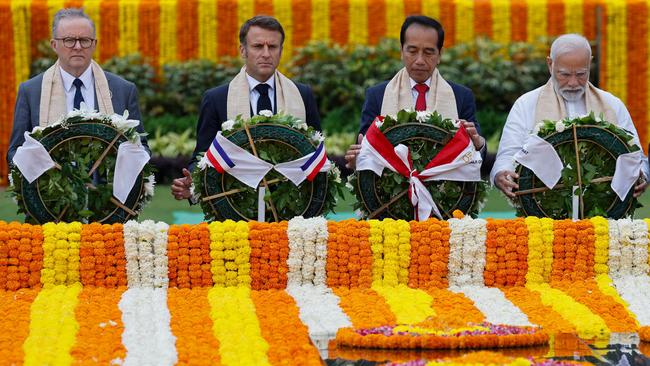Acronyms but no action in G20’s widening world of waffle
By the time you read this column, the G20 leaders’ communique will have been released, featuring banal promises to strive for resilience, sustainability, inclusion and stability.

For all the media buzz surrounding the annual G20 meetings, and their significant and growing cost in time and money, very little of consequence has emerged from the forum in recent years and its future utility can only diminish.
The writing is already on the wall: Xi Jinping didn’t attend this year. Mexico’s President, Andreas Obrador, hasn’t bothered to go for years.
By the time you read this column the G20 leaders’ communique from this year’s Delhi summit will have been released, but almost no one will read it. And no wonder: last year’s G20 leaders’ statement ran to a remarkable 9700 words of meaningless, tiresome waffle.
The latest one will almost certainly feature the same banal promises to strive for resilience, sustainability, co-operation, inclusion and stability.
No doubt leaders obtain some benefit from meeting their counterparts face to face, but the sheer size of these gatherings has undermined the quality of such interactions, which typically occur briefly on the sidelines of the summit.
It’s wrong to say the meetings are harmless, because time is limited. Leaders could instead be tending to more pressing domestic matters or even pursuing bilateral meetings from which they would glean greater mutual understanding. It distracts leaders’ focus from the United Nations. Had US President Joe Biden not been so engrossed in attending summits, he might have had time to visit Australia earlier this year.
The G20 began in 1999 as a practical forum for finance ministers and central bank governors from big economies to co-ordinate better in the wake of the Asian financial crisis. A decade later it was expanded to include heads of government in the wake of the global financial crisis.
Since then it has become almost a parallel UN, a travelling circus of bureaucrats, think tanks and “working groups” seeking to railroad nations into standard responses to climate change, foreign policy, gender discrimination, pandemics, and even “misinformation”.
For instance, last year’s meeting trumpeted a “Financial Inclusion Framework on Harnessing Digitalisation to Increase Productivity and Foster a Sustainable and Inclusive Economy for Women, Youth and MSMEs or Yogyakarta Financial Inclusion Framework guided by the G20 2020 Financial Inclusion Action Plan”.
That’s a direct quote from last year’s communique, by the way.
If you’d wondered why the G20 “family photo” of leaders always seem to include a lot more than 20 people, that’s because 20 has become a rather misleading description.
The G20 has suffered the same problem as the G7 did before it, which became the G8, then the G8+5: relentless expansion of scope and participation, making meaningful agreement ever more difficult. This year India invited Bangladesh, The Netherlands, Nigeria, Egypt, Mauritius, Oman, Singapore and the United Arab Emirates. Spain remains a “permanent guest”, apparently, although its President couldn’t attend this year owing to a positive test for Covid-19.
That’s not all. The list of participating organisations is epic, and worth quoting in full. Last year’s Indonesia G20 meeting included attendees from the World Bank Group, IMF, OECD, Asian Development Bank, ERIA, CEPI, European Investment Bank, GGGI, ICAO, IEA, IEF, IFAD, ILO, IRENA, FAO, FSB, Gavi, Global Fund, IAEA, Islamic Development Bank, ITU, Medicine Patent Pool, Sustainable Energy for All, OPEC, WEF, WFP, WHO, WTO, UNCCD, UNCTAD, UNDESA, UNDP, UNECE, UNESCAP, UNESCO, UNFCCC, UN Global Pulse, UN Habitat, UNICEF, UNIDO, UNOPS, UN Women, UNWTO and the G20 Engagement Groups (W20, L20, T20, S20, Y20, SAI20, P20, C20, B20, U20).
The growth of the G20 reflects a broader problem: the proliferation of international summits. The G20 competes with ASEAN, APEC, NATO, the G7 and of course the big new summit in town: the COP, to co-ordinate the response to climate change.
Rationally, it’s hard to explain this phenomenon. The speed of international air travel has barely changed since the 1960s, yet the number of summits has exploded. At the same time, technology has made it easier for leaders to communicate without meeting in person.
The world did a very good job of avoiding major wars for decades after the Second World War without an intense calendar of summits. Leaders met when they needed to, and otherwise dispatched senior civil servants to iron out the details of international agreements.
Reversing the summit glut will prove difficult, if not impossible. Like any government department, once established summits take on a life of their own.
The expansion last month of the BRICS group of nations (led by China and Russia, as a counterpoint to the US-dominated G7) to include Saudi Arabia, Iran, Ethiopia, Egypt, Argentina and the United Arab Emirates has prompted concern in some quarters in Washington the group would seek to dethrone the US dollar.
But that organisation too will find that increasingly it cannot reach any meaningful decisions with such a large group of disparate nations, however desirous of a “multipolar world” they all might be.
Criticism of the summit bonanza tends to be rare because the media and political class benefit from them.
Summits can provide pleasant travel opportunities for thousands of bureaucrats, who each year descend on major, sometimes exotic, destinations to enjoy top-class dining and accommodation, all at taxpayers’ expense. They provide bountiful opportunities for grandstanding and photo opportunities for politicians.
While employees are dragging the chain in returning to the office post-Covid, there’s been a full “return to work” on the international summit front.
A good start would be for the G20 to meet only every few years, which could increase interest in the event among the public, who are ultimately paying hundreds of millions of dollars for the annual extravaganza.





Can you think of the last time a decision at the G20 affected your life? I can’t either. In fact I can’t even think of one that affected Australia in any meaningful way.